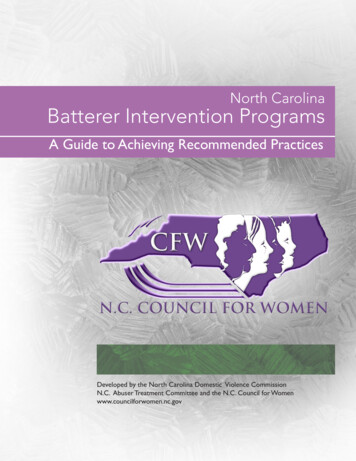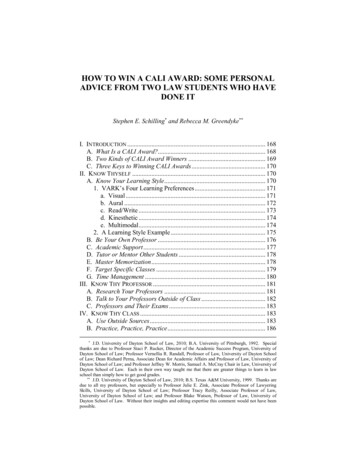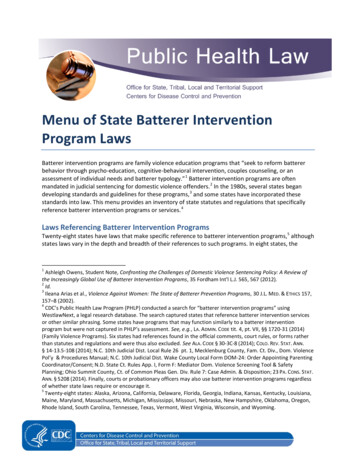
Transcription
B at t e r e r I n t e r v e n t i o nsystems in C aliforniaAn EvaluationADMINISTRATIVE OFFICEOF THE COURTSOFFICE OF COURT RESEARCH
B at t e r e r I n t e r v e n t i o nsystems in C aliforniaAn EvaluationDag MacLeodRon PiDavid SmithLeah Rose-GoodwinADMINISTRATIVE OFFICEOF THE COURTSOFFICE OF COURT RESEARCH
Judicial Council of CaliforniaAdministrative Office of the CourtsOffice of Court Research455 Golden Gate AvenueSan Francisco, California 94102-3688This project was supported by Award No. 2005WGBX0004 awarded by the NationalInstitute of Justice, Office of Justice Programs, U.S. Department of Justice and with thesupport of the Administrative Office of the Courts, Executive Office Programs Division,Office of Court Research. The opinions, findings, and conclusions or recommendationsexpressed in this publication are those of the authors and do not necessarily reflect the viewsof the Department of Justice or the Administrative Office of the Courts.Copyright 2009 by Judicial Council of California/Administrative Office of the Courts. Allrights reserved.Except as permitted under the Copyright Act of 1976 and as otherwise expressly providedherein, no part of this publication may be reproduced in any form or by any means, electronicor mechanical, including the use of information storage and retrieval systems, withoutpermission in writing from the copyright holder. Permission is hereby granted to nonprofitinstitutions to reproduce and distribute this publication for education purposes if the copiescredit the copyright holder.
AcknowledgementsThe authors of this report would like to express their deep gratitude to the judges, courtstaff, department of probation staff, and batterer intervention program directors and staffin Los Angeles, Riverside, San Joaquin, Santa Clara and Solano Counties. The researchthat informs this report would not have been possible without their generous support.These professionals have dedicated their lives to eradicating domestic violence. Despitetheir busy schedules and other commitments, they made the time to actively assist withthe collection (and sometimes the interpretation) of data while providing constructivecriticism and challenging the research team to think harder about the complex issuesinvolved in the justice system’s intervention in domestic violence cases.The authors would also like to express their appreciation to their colleagues at theAdministrative Office of the Courts who contributed directly and indirectly to theresearch design, data collection, and analysis. Current and former Office of CourtResearch staff Yueh-Wen Chang, Selina Hung, Kevin O’Connell and Ruth White allassisted with data collection at various points in the project. Members and staff of theDomestic Violence Practice and Procedure Task Force were also instrumental in assistingwith the project. External support was provided by Professor Eric Mankowski, whoprovided the team with a psycho-social measurement instrument to assess changes inoffender attitudes and beliefs. The Research Advisory Committee, consisting ofProfessors Donald G. Dutton, Theodore Eisenberg, and Lorena Garcia, and Andrew R.Morral of the RAND Corporation, offered invaluable critique on the design and analysisof the research. Any errors or omissions remain the sole responsibility of the authors.Finally, the authors wish to thank Bernard Auchter, grant monitor at the Department ofJustice, who provided essential logistical support in navigating the grant managementprocess as well as thoughtful comments related to the original research design.i
AuthorsDag MacLeod, Ph.D., is the manager of the Office of Court Research, Executive OfficePrograms Division of the Administrative Office of the Courts (AOC) of California andhas worked for the AOC since 1999. He received his Ph.D. in sociology from the JohnsHopkins University.Ron Pi, Ph.D., is a Supervising Research Analyst in the Office of Court Research and hasworked for the AOC since 2000. He received his graduate degree in political economyfrom the University of Texas at Dallas and bachelor’s degree in foreign languages andliterature from the National Taiwan University.David A. Smith, Ph.D., is a Senior Research Analyst with the Office of Court Researchand has worked for the AOC since 2002. He received his Ph.D. from the University ofMichigan in psychology and a master’s from the University of California, Berkeley in aninterdisciplinary program in public health (social epidemiology) and environmentalplanning.Leah Rose-Goodwin, M.P.P., has worked for the Office of Court Research since 2004and is currently a Senior Research Analyst. She received her Master’s Degree in publicpolicy from the University of California, Berkeley and a Bachelor’s Degree in politicalscience from the University of California, San Diego.ii
Table of ContentsAcknowledgmentsiAuthorsiiExecutive SummaryvChapter 1. Evaluation of California’s Batterer Intervention Systems1Chapter 2. Five Batterer Intervention Systems in California17Chapter 3. Batterer Intervention Program Content33Chapter 4. Offender Profiles51Chapter 5. Analysis of Systems Impacts67Chapter 6. Policy Issues and Research Implications97Appendices107iii
National Institute of Justice Grant Number 2005WGBX0004iv
Batterer Intervention Systems in California:Executive SummaryDomestic violence represents both a serious criminal justice and public health problem. Everyyear in California over 100,000 arrests are made for misdemeanor and felony domestic violencecharges while countless additional cases of intimate-partner violence go unreported. The social,economic, and personal costs of domestic violence make it a critical area for evaluating theeffectiveness of the justice system response to this crime.Since 1994, California law has required defendants who are convicted and granted probation indomestic violence cases to complete a certified batterer intervention program (BIP). In addition,recognizing the severity of the problem of intimate-partner violence and the unique challengesthese cases present, many superior courts in California have adopted specialized procedures forhandling domestic violence cases such as using dedicated calendars and holding periodic reviewhearings with offenders.This study seeks to take advantage of the fact that each jurisdiction in California manages itsdomestic violence caseload somewhat differently. We begin by documenting the different waysthat courts, departments of probation, and BIPs intervene with domestic violence offenders in asample of five jurisdictions—Los Angeles, Riverside, San Joaquin, Santa Clara and Solano. Wethen compare the efficacy of the justice system response across jurisdictions, looking primarily atdifferences in rates of program completion and re-offense by offenders.Drawing on a sample of over a thousand men enrolled in treatment programs across the fivejurisdictions, this study is the largest of its kind ever conducted. 1 It lays the foundation forimproving the justice system response to domestic violence and for future research to untanglethe complex relationships among the individual characteristics of men who commit domesticviolence, the BIPs that are charged with treating these men, and the efforts of courts anddepartments of probation to hold offenders accountable and ensure victim safety.Findings The men who find their way into the justice system and ultimately enroll in BIPs appearto be non-representative of the larger social problem of domestic violence. The sample ofmen convicted of domestic violence offenses drawn for this study generally had lowlevels of educational attainment, were poor, majority Hispanic, and had lengthy criminalrecords; Slightly more than one third of the men convicted of domestic violence in our samplereport that they still live with their victim; about one third of the men reported that theylive with children;National Institute of Justice Grant Number 2005WGBX0004v
BIPs appear to incorporate multiple approaches to intervention with domestic violenceoffenders into their programs, integrating components of cognitive behavioral therapy,the Duluth model and other methods that they determine are appropriate and effective; The educational topics that BIPs identified as important to helping offenders end theirabuse appear to be consistent with the legislative requirements for these programs; Offenders’ rates of program completion varied across different BIPs. The reason for this,however, appears to be in part that the characteristics of men who are enrolled in differentBIPs varies systematically across programs. The statistical significance of the differencesin program completion across BIPs declines as additional, individual-level variables areadded to the model; In contrast to the weak correlation between program completion and BIP, there is nostatistical association at all between programs and an offender’s likelihood of re-offense; For offenders who successfully completed the 52-week BIP, attitudes and beliefs showedsmall, positive, changes along a number of dimensions including taking greater personalresponsibility, understanding the effect of abuse on others, and anger management; The strongest predictors of whether or not men were re-arrested following intake in a BIPwere individual characteristics of the offenders, not the characteristics of jurisdictions orBIPs in which offenders were enrolled. 2 Men who were more educated, older, had shortercriminal histories, and did not display clear signs of drug or alcohol dependence had alower likelihood of re-arrest; Whether probation or the court is primarily responsible for oversight of the offendersmade no difference in the likelihood of re-arrest. This finding is similar to the conclusionof a recent study in which judicial supervision of domestic violence offenders—withcomparisons between supervision of different intensity and compared with no supervisionat all—was found not to make any significant difference on recidivism 12 months aftersentencing; 2 Even after controlling for individual characteristics, two jurisdictions showed statisticallysignificant differences in outcomes for offenders. Using Los Angeles as the base forcomparison, offenders in Solano County had a likelihood of re-arrest at 12 months afterintake that is one-third the likelihood of offenders in Los Angeles County, whileoffenders in Santa Clara County were 1.6 times as likely to be arrested as offenders inLos Angeles.National Institute of Justice Grant Number 2005WGBX0004vi
Implications for Policy Because of the salience of individual characteristics in predicting program completionand re-offense, enhanced risk and needs assessment at intake may improve offendertreatment.Penal Code §1203.097(b)(1) lays out detailed offender assessment requirements butlimits these to offenders who are on formal probation. The collection of information onbasic risk and needs factors of offenders who are informally as well as those that areformally supervised by probation would allow BIPs to tailor their treatment morenarrowly. Drug/alcohol treatment may be essential to help offenders end their abuse.Indicators of risk for drug and alcohol abuse are strong predictors of non-completion ofbatterer intervention programs and senior program staff in the BIPs generally agreed thataddressing the topic of alcohol and drug abuse is important to helping offenders end theirdomestic violence. Because many BIPs have limited resources and little leverage overoffenders enrolled in their programs, it may be useful for departments of probation andthe courts to consider how best to support BIPs in requiring batterers at risk for substanceabuse to attend some reasonable form of drug/alcohol treatment in conjunction with theirenrollment in the BIP. The current BIP fee structure may hinder differentiated case management.Enhanced risk and needs assessment combined with heightened attention to drug/alcoholabuse suggest that the justice system may need to engage in more differentiated casemanagement with domestic violence offenders. One more piece of the puzzle ofdifferentiated case management has to do with fees.The current method of assessing and paying fees, all managed at the BIP level, may posea barrier to a differentiated treatment model because Pen. Code §1203.097 mandatesprobation departments to evenly allocate referrals of indigent clients among approvedprograms. Thus, the effort to assign the right socioeconomic balance to differentprograms may undermine efforts to assign men to programs on the basis of thecharacteristics that put them most at risk for re-offense.Moreover, it is not clear that enough higher-income men are available in the system tocross-subsidize the costs of the lower-income men in programs. Creating a moredifferentiated treatment model might require an exploration of alternative fee distributionand payment plans. This might grant BIPs the financial freedom to accept enrollments onthe basis of service need rather than have to consider a client’s ability to pay.National Institute of Justice Grant Number 2005WGBX0004vii
Implications for Research The effort to understand the impact of the justice system as a whole is hampered byvariation within jurisdictions.Differences in court practice from location to location within jurisdictions, as well aslarge variability in outcomes across BIPs within jurisdictions undercut efforts to evaluatethe justice system response. Instead, in some cases we have findings related to differentsystems within a single jurisdiction that cannot be completely disentangled.Further integration of the qualitative data will assist with the interpretation of thefindings. Once the qualitative differences within jurisdictions are better understood,quantitative analysis that excludes outlying court locations where these introduce toomuch variability might be a fruitful path for recapturing the system perspective thatmotivated this study. Given the clustering of large numbers of offenders in specific courtsand in some specific BIPs, this may be a near- to medium-term follow-up study with thisdata set. Clearer specification of system intervention measures is needed.System intervention measures such as “probation contact,” “court review,” or even“attendance” at a BIP are all inherently limited by the variability in how theseinterventions occur across locations. Consistent with the other observations here, morequalitative information on what these variables really are in practice—whether probationcontact is a face-to-face interview at the department of probation as opposed to a check-inby telephone or whether the review at the trial court is in open court in front of a judge orhandled by a courtroom clerk—will assist in distinguishing among different systems. More information on BIPs is needed to understand and identify promising practices.The challenge of interpreting outcomes given the variability across jurisdictions iscompounded by variability across BIPs. Although this study captured measures of BIPpriorities for teaching and training related to different elements of the intervention, thefindings did not show sufficient variability to introduce the data into our quantitativemodels and to begin teasing out the effects that these programs produce on offenderoutcomes.In the future, this information will need to be combined with independent measures if weare to clearly understand the approach intervention programs are taking in their workwith clients. Further, we need to learn more about BIPs as practitioner groups and/ororganizations in terms of their staffing levels and role differentiation, the training andprofessional experience levels of program staff, the supplementary services BIPs are ableto provide clients directly or indirectly, and the resources these organizations have at theirdisposal to sustain their work with batterers. Such information is essential to our ability tounderstand BIPs in their various organizational forms, as well as to identify promisingprogram approaches and practices.National Institute of Justice Grant Number 2005WGBX0004viii
Layout of the ReportThis report is organized to isolate and describe the variation that is found at different levels ofanalysis in the five study jurisdictions. After introducing the study in Chapter 1, Chapters 2through 4 move from the highest level of analysis – the jurisdictional differences across counties– to successively lower levels of analysis – the BIPs, and then the individuals within theprograms. In Chapter 5, the variables that are described in the preceding chapters are broughttogether for the final evaluation of outcomes. Chapter 1 outlines the research design and methodology employed. This chapter placesthe study in the context of previous research on this topic, lays out the logic model for thestudy, defines the study population, and discusses the various types and sources of datacollected;Chapter 2 provides an overview of the five jurisdictions in the study including bothqualitative description of the coordination of domestic violence cases among justicesystem partners and quantitative measures of court and probation oversight of offenders;Chapter 3 looks more closely at the actual content of BIP curriculum and teachingstrategies in the study jurisdictions. This chapter describes the findings of a survey of 45BIPs in the study jurisdictions on the educational topics and teaching methods employedby BIPs;Chapter 4 describes the offenders enrolled in the study, including detailed information onage, race/ethnicity, family living arrangements, educational attainment, income levels,criminal history, and risk of drug/alcohol dependence;Chapter 5 brings together all of the variables described in the preceding chapters toevaluate the impact of the jurisdiction on two primary outcome measures: programcompletion and re-arrest. This chapter also evaluates changes in attitudes and beliefsamong a smaller sub-sample of men who completed the BIP during the study period;Chapter 6 summarizes the study findings and looks at the implications for both policy andresearch.National Institute of Justice Grant Number 2005WGBX0004ix
Endnotes Executive Summary1. This study looks exclusively at men who committed domestic violence offenses against female partners in aneffort to understand the justice system response to the largest proportion of the domestic violence caseload and tominimize the variability within the sample.2. All findings discussed in this Executive Summary are statistically significant at a level of .01 or .05 unlessotherwise noted.3. Melissa Labriola, Michael Rempel, and Robert C. Davis, Testing the Effectiveness of Batterer Programs andJudicial Monitoring, Center for Court Innovation (November 2005).National Institute of Justice Grant Number 2005WGBX0004x
Chapter 1: California’s Batterer Intervention SystemsIntroductionEvery year in California over 100,000 arrests are made for misdemeanor and felony domesticviolence charges. 1 Since 1994, California law has required defendants who are convicted andgranted probation in these cases to complete a certified batterer intervention program (BIP). 2 Inaddition, recognizing the severity of the problem of intimate-partner violence and the uniquechallenges these cases present, many superior courts in California have adopted specializedprocedures for handling domestic violence cases such as using dedicated calendars and holdingperiodic review hearings with probationers.Adopting specialized procedures for handling domestic violence cases generally requires thatcourts coordinate their activities more closely with other justice system partners. Lawenforcement, district attorneys, public defenders, the courts, probation departments, BIPs,victim-assistance programs, and other social service providers compose a batterer-interventionsystem. Working together, they form the system that confronts batterers with a variety ofpotential sanctions—ranging from incarceration to intensive monitoring by probation and thecourts—as well as a requirement for rehabilitation through mandatory counseling andeducational programs designed to change the attitudes and behavior of batterers.Despite the clear interdependence of different justice system partners in the monitoring ofdomestic violence offenders, research on the efficacy of the justice system response to domesticviolence has historically focused on individual components of the system. As a result, whilearrest policy, domestic violence court monitoring, and BIP treatment modality have all beenstudied to determine the impact of these interventions, it remains unclear which elements of thesystem—sanctions, judicial review, frequency of review, intervention program modality, or somecombination of these and other factors—ultimately reduce the likelihood of further violence bythe batterer.This study takes a systems perspective in evaluating the oversight of domestic violence offendersin five counties in California. The goal is not to study the effectiveness of these differentjurisdictions per se, but rather to specify the system components and collaborative relationshipsamong justice system partners that are most likely to improve compliance with court-orderedtreatment programs and reduce re-offense in domestic violence cases. This study looks todocument the differences that exist across jurisdictions and to understand the combined effect ondomestic violence offenders of court, probation, and BIP oversight in different jurisdictions.California’s large population makes the state’s justice system particularly well-suited for thistype of evaluation. The large number of participants attending batterer intervention programs inthe state made it possible to study a sample that provides greater confidence in the significanceof the findings than in previous studies. Recent studies by Davis et al. and Feder and Forde 3 usedtotal sample sizes of 376 and 404 respectively. In a four-site, cross-state evaluation conducted byGondolf, the total sample size is 840. 4 This report draws on a sample of over a thousand menenrolled in treatment programs in five jurisdictions in the state.National Institute of Justice Grant Number 2005WGBX0004Page 1
In addition, the diversity of both case processing and BIP treatment models within a commonlegal framework makes it possible to hold a number of important factors constant while studyingthe effects of a range of other variables in the operation of the batterer intervention system.Regularly scheduled review by the court and the frequency of that review, frequency of oversightby probation, BIP treatment modality, and coordination among justice system partners can all beevaluated for their effect on offender compliance with the terms of probation and likelihood ofreoffense. Rather than use random assignment—which has proved problematic in previousstudies of batterer intervention programs—this study uses a quasi-experimental design, takingadvantage of existing variation in the monitoring of batterers in California. 5The methodology and operationalization of measures is discussed in more detail below, but inbrief the study isolates specific components of the batterer intervention system to assess howdifferences in the system interventions affect outcomes for men who are in the system. 6 Figure1-A presents the logic model of the study and refers to these components of the battererintervention system as “system characteristics”; it shows the logical relationship between thesesystem characteristics, the characteristics of batterers, and the outcomes that the justice systemseeks.Figure 1-A. Logic Model of Study Including Principal VariablesLiterature ReviewIn their review of the literature on batterer intervention, Davis et al. organize this research intothree categories. Early research is characterized by studies that were largely qualitative andNational Institute of Justice Grant Number 2005WGBX0004Page 2
descriptive seeking a better understanding of batterers, victims, and how the justice system andintervention programs work. Typically these studies lacked comparison groups against which toevaluate the outcomes. 7 More recent work in the field focuses on comparative outcomeevaluation and can be classified into those that are based on experimental design and those thatare based on quasi-experimental design. 8Regardless of design and methodology, research into the effectiveness of court-ordered treatmentfor batterers and periodic review of batterers has produced mixed results on whether or not theseprograms reduce the likelihood of further violence from an abusive partner. 9 One of the mostexhaustive studies to date evaluated four sites in four different states and concluded that “thesuccess of the programs appears to be related to the intervention system as a whole, and theprograms may be inextricably embedded in the larger system.” 10Perhaps the most important reason for the uncertainty regarding program effectiveness is theexistence of vast differences in the design and implementation of batterer intervention systemsacross the country. Comparative studies that can hold very little constant across multi-siteevaluations face an enormous challenge in disentangling the impact that different components ofthe system contribute to program effectiveness. Furthermore, differences in system componentsare usually operationalized and measured with insufficient detail. Comparison groups are oftendichotomized on the basis of the presence or absence of certain components, making the programa black box.A growing body of literature on implementation analysis points to the importance of looking intothe black box. By identifying and measuring system components more carefully, it is possible tolink process evaluation with outcome analysis. 11 This study takes advantage of existing variationin system components at the level of the courts, probation, and batterer intervention programs.Because these components operate within a common statutory framework, a number ofimportant system-level variables are held constant.Research Design and MethodsAs noted above, this study is designed as a quasi-experimental evaluation of batterer interventionsystems. Although the statutory framework governing the handling of domestic violence cases inCalifornia applies statewide, important differences across counties make it possible to identifyand measure different case-processing practices within county jurisdictions—the system—and toevaluate the impact of these practices on outcomes for domestic violence offenders.This section describes the operationalization of the research design, the methods used to evaluatedifferent components of the system, data collection instruments, and the data set on which weconduct analysis in subsequent chapters. We use both qualitative and quantitative methods todescribe the various components of the justice systems in the study while the outcome data isentirely quantitative.National Institute of Justice Grant Number 2005WGBX0004Page 3
Changes to Original Study MethodologyCourt and Probation JurisdictionsThe initial study design proposed to construct a sample in which half of the jurisdictions useddedicated domestic violence calendars and regularly scheduled review hearings, and the otherhalf did not. Other considerations included finding courts that represented both Northern andSouthern California and identifying jurisdictions large enough to provide substantial numbers ofdomestic violence offenders for the study over the course of three months of intake. Based onthese criteria, the Superior Courts of Contra Costa, Los Angeles, Riverside, San Joaquin, SantaClara, and Solano Counties were invited and agreed to participate in the research study.However, before data collection started, Contra Costa County decided not to participate.Although the superior court and probation department had both agreed to provide the necessarydata, some directors of the BIPs in the county were reluctant to take part. Many BIPs wereparticipating in another research study at the time, and several felt it would be too difficult tomanage the additional workload required to participate in this study.The effect of losing Contra Costa County as a study jurisdiction at first appeared to be negligible.Enrollment projections provided by BIPs that had agreed to participate in the other fivejurisdictions suggested that there would be more than enough subjects to compensate for the lossof Contra Costa, so a decision was made not to recruit another study county.Program FidelityThe original study proposal envisioned identifying the principal treatment model of BIPs in thestudy jurisdictions, developing quantitative measures of these treatment models, and assessingthe fidelity of the programs’ adherence to the models. Researchers and policymakers in healthand education have long recognized the importance of measuring how faithfully interventionmechanisms are implemented at the program level in order to draw accurate conclusions aboutthe impact of different models. Program fidelity has only recently been addressed in domesticviolence research. 12In our evaluation of program models, however, it became clear that different intervention modelsas practiced in California are not distinct enough to allow for the clear categorization ofprograms, let alone for the measurement of program differences according to categories. Eventhose BIPs that self-identified as adhering to one model or another borrow heavily from varioustraditions in their curricula and teaching style in practice. This finding prompted the researchteam to adopt a new approach in assessing the substantive content of BIPs.Rather than evaluate the fidelity of programs to models that could not be fully disentangled fromone another, we administered a survey of program content and teaching approach to BIPs in ourstudy jurisdictions. This survey was devel
Michigan in psychology and a master's from the University of California, Berkeley in an interdisciplinary program in public health (social epidemiology) and environmental planning. Leah Rose-Goodwin, M.P.P., has worked for the Office of Court Research since 2004 and is currently a Senior Research Analyst.










